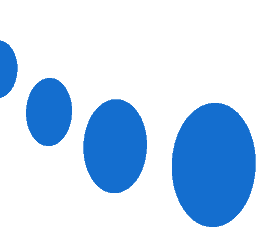A company’s growth is based on 3 pillars: the product, the team and the customers. This article will focus mainly on customers, and more specifically on marketing actions to see how we can improve them. When it comes to customer acquisition, there are 2 main levers to bear in mind: Inbound Marketing and Outbound Marketing.
Inbound marketing is the act of attracting prospects to you, and this involves a variety of actions: SEO, SEA, podcasts, tutorial videos, white papers… This requires a lot of time and investment, as well as a strong editorial line and branding.
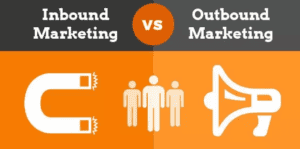
Generally speaking, I tend to find that solid companies (not those that go out of business after 2 years) have a customer acquisition split as follows: 70% Inbound marketing and 30% Outbound marketing. It’s a lever for stability. Why stability? Because it’s in the 70% that you generate the customers you need to keep your business going: paying for office space, salaries, related expenses… Inbound and Outbound Marketing may seem radically different at first glance, but they are interdependent and complementary. Nevertheless, it’s in the 30% that Outbound Marketing provides us with that we have much of the pure growth, where it’s the prospects who, by listening to them, shape the future of your product and your business model.
In this article, we take a closer look at these famous 30%.
What is Outbound Marketing?
Definition of "Outbound Marketing" or "Outbound Acquisition
Outbound marketing encompasses all “outbound” strategies and actions, whereas inbound marketing encompasses all “inbound” actions. Instead of the prospect coming to you, it’s your sales people who go to the prospect.
Outbound marketing is a powerful lead-generating lever that companies (especially in France) often make little or no use of.
But why? We all have in mind that image of the vacuum cleaner salesman who rings your doorbell to sell you the latest Nimbus 3000 vacuum cleaner that doesn’t lose suction, all surface… Oops, I digress! So, you get the idea? When properly mastered, Outbound Marketing is a highly effective and indispensable lever for feed your lead pipeline.
We tend to distinguish between 2 terms: outbound marketing and inbound marketing. This is a mistake! The two strategies are complementary and intertwined in many ways. For example, a strong brand and a pull marketing strategy will support the salesperson’s actions, reinforcing his credibility in the eyes of potential prospects and consequently strengthening his push marketing actions. Outbound marketing, on the other hand, is about (at the very least) making your service or product known, but also about listening to your future consumers . The sales team will feed your entire team so that it can adapt your company’s overall marketing strategy. Check out this article to learn more about the difference between Outbound and Inbound marketing.
Now that we’ve quickly put things into context, let’s zoom in on the benefits of a good outbound marketing strategy.
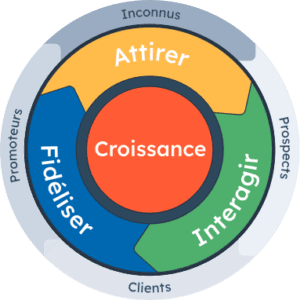
The benefits of Outbound Marketing
The benefits of an outbound marketing campaign are twofold:
-
Feed your sales pipeline over the short/medium/long term
-
Shaping your product or service to your prospects’ needs
The constant feeding of a commercial pipeline is the keystone of any growing business. Return on investment or ROI is measured per outbound campaign, not between inbound and outbound.
A lead pipeline needs to cover all 3 phases of acquisition: short/medium/long term. Indeed, I’ve (too) often seen great companies go after only the big deals, forgetting about the “small” ones. Let’s break the suspense: this strategy is wrong. Big deals are tempting from the outset, but they have to come at a specific stage in your development. Often, these potential results take time, both on your side for prospecting and closing, and especially on the customer’s side! It’s not uncommon to see companies go out of business with big deals on the horizon. However, you need to manage your outbound campaigns as a distribution of ads budgets. For example, here’s the breakdown of Stepward’s strategy at the time of writing (Tuesday October 4 at 7:48 a.m. for the fussy among us):
-
Small deal: 40% off
-
Medium deal: 35
-
Big deal: 25% discount
This breakdown changes every quarter according to the development of our business and our ROI. In the early days of Stepward, we didn’t even have a percentage allocated to large deals, we weren’t structured for that and we had to bring in new customers quickly to feed our production team and increase our cash flow.
In addition to the financial aspect of your outbound communication, your prospecting capacity is important. If you’re on your own and can’t rely on a sales force, you need to save time. Outbound marketing is often time-consuming and requires a high level of morale. To help you, I invite you to read this article “What should I automate as a salesperson?”. Automation never replaces a salesperson’s work, but allows him or her to concentrate on surgical prospecting, closing and writing sales proposals.
Outbound marketing is also of strategic interest, as it enables you to gather the potential needs of your future customers directly and in real time. We have a tendency to caricature and talk about the technophile complex (as opposed to “Fake it until you make it”), which suggests that the most accomplished product sells more easily. That’s not true at all! Having seen it for many years in a startup gas pedal, the best companies develop their product or service based on feedback from sales. Sales people are your ears to better understand your users. If we compare it to your inbound strategy, never (or you’re lucky) will a prospect from an ad say “My need is more about X, can you help me?”. It’s during an appointment when your sales rep is in his “Discovery” phase that he’ll be able to listen to all the customer’s issues. Set up a spreadsheet on Notion (or similar) where sales reps can record all your prospects’ ideas and needs. At Stepward, we call it the “2nd brain”. At the same time, it feeds all our content, our content marketing, which has a direct impact on our inbound marketing.
Sales prospecting is only relevant and feasible if your average ticket includes a few 0s, as an outbound strategy can be costly in terms of time and money. That’s why an Outbound strategy is regularly implemented for companies with a B2B or B2C but “high ticket” offer.
To minimize costs and optimize your time and that of your sales force, cold acquisition must be accompanied by a growth hacking strategy. Chere are a number of techniques for maximizing ROI. Let’s take the example of one of our customers, whom we’ll call Bastien for greater discretion. We deployed two outbound channels for its 5 sales people: LinkedIn and Email.
Linkedin and email channels are perfect examples of outbound marketing campaigns.
Bastien and his sales team have the ability to deploy a major outbound marketing strategy. BEFORE our support, here’s a typical day in the life of one of our sales reps:
-
Weekly check-in with Bastien to find out which targets to prospect
-
Look up the name of the target company on Google and the name of the manager on LinkedIn.
-
Call the number suggested on the site
-
Repeat until the manager is on the phone
-
Appointments
-
Follow-up and potential closing
Here we see several points that can be radically optimized. Where the salesperson has a high value-added impact is on points 5 and 6. The other points can be automated. Here’s a typical day in the life of one of our sales reps AFTER our support:
-
Prospecting file received in the morning
-
Processing responses on LinkedIn and in your inbox
-
Appointments
-
Monitoring and updating your CRM
-
Closing
Thanks to the automation of channels such as LinkedIn and e-mail, sales reps now spend 90% of their time with or following up customers. With the same prospecting volumes, Bastien would have needed between 4 and 7 extra sales reps to achieve the same results! In addition to the human value that automation can bring, it gives sales reps more time for surgical prospecting. For example, for key account targets, it’s not surprising to have to increase the number of contact points to 10 or even 20 before signing with them.
In the second part of this article, we’ll look at how to deploy an Outbound strategy on LinkedIn. Regarding direct mail, I invite you to consult our article “B2B emailing, a good acquisition channel“.
Would you like support for your outbound campaign?
LinkedIn Sales Navigator, the main lever in Outbound Marketing
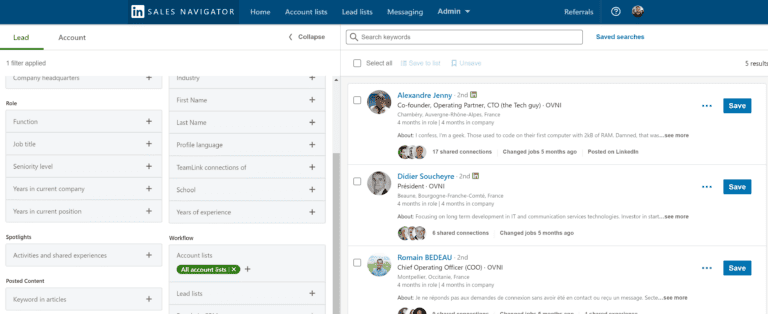
How to make the most of LinkedIn Sales Navigator
The first thing to do when we decide to implement or optimize our Outbound Marketing campaigns is to focus on the quality of the prospecting file we’re going to provide to our sales force. There are several techniques for this. For me, buying databases is no longer an option for two reasons: price and quality. Data “wholesalers” update their data little or not at all, wasting your sales force’s valuable time. But with a good knowledge of LinkedIn Sales Navigator (and a few techniques), it’s easy to build up an up-to-date, relevant database. You’ll see the differences between your own databases and those of “wholesalers”!
LinkedIn Sales Navigator consists of 3 main parts:
-
Prospect filters
-
Company filters
-
The Lists
As for the 3rd point, we won’t go into it in this article. However, it’s worth taking a look at it and getting trained so that you can “hunt” for a company on a medium/long-term basis. For example, this feature gives you global visibility of the target company, such as its latest news or the growth of its workforce in a specific department. This is interesting for Stepward, which supports sales and recruiting staff in B2B companies.
There are 3 types of filters for both lead and company filters:
-
The main ones who represent the “radical” of your target. Example: you’re looking to contact the HR department. So, one of your main filters will be all the synonyms in the HRD Jobtitle (check out Pharrow’s Parsinator for this).
-
Secondary products that are mainly used for copywriting. This data will enable you to personalize your approach and gain initial insights. For example, Aircall based much of its outbound prospecting on the company filter: “workforce growth”.
-
The tertiary ones, which are used only for the exclusion of large searches. You can’t scrap more than 1,000 companies per company search and more than 2,500 per prospect search.
As far as lead filters are concerned, here are the filters I think you should use to have accurate databases. It’s better to target databases of 300 to 500 people than to have a direct prospecting file of 2,000 people. Run your own tests, and you’ll see the difference in terms of acceptance and response rates!
Prospect filters :
-
Main filters: Jobtitle (not keywords), Catchment area, Company size, Head office location
-
Secondary filters: hierarchical level, number of years with the company and keywords
-
Tertiary filters: Number of years in position and company type
Why isn’t the sector there? Great question! 😉 As you can see on your LinkedIn Sales Navigator, the “Sector” filter is in the “Personal” category and not “Company”, which skews the result enormously! In fact, many LinkedIens fill in their LinkedIn profile incorrectly, and it’s not necessarily their fault. For example, someone working in marketing will tend to be classified by LinkedIn in the “Marketing and Advertising” sector, even though they work at Ilek. To optimize your database, I advise you to use the double filtering technique with company filters.
Company filters :
-
Main filters: Company size, Sector and catchment area
-
Secondary filters: Growth in workforce, technology used and recent activities
-
Tertiary filters: Recruiting on LinkedIn and the catchment area
Once you’ve completed your search, you’ll save all the companies (your search must not exceed 1000 companies) in a “Company List”. Then all you have to do is go back to your lead filters and select your registered company list. This will enable you to scrape only people matching your criteria from registered companies. It’s not an easy mechanic to understand. To help you memorize it, take a picture of a wardrobe. When you create company lists, you build your wardrobe, then the lead filters are just the drawers in the wardrobe.
Once you’re happy with your LinkedIn research, you need tools to extract information from LinkedIn for prospecting purposes. And there are a number of tools at your disposal!
Need a hand building your databases?
Automation on LinkedIn
Automation on LinkedIn needs to be as precise as possible, because more and more people start prospecting without any knowledge of Sales Navigator, and contact people who will never be consumers. This generates a mass of messages for your interlocutor, and you need to know how to differentiate yourself. We’ll talk about how to produce good copywriting in another article, but one thing’s for sure: the data collected in phase 1 will feed it! Not all sectors, not all companies of all sizes, and certainly not all consumers, contact each other in the same way. Copywriting has a direct impact on your results.
Here’s a non-exhaustive list of tools I use to scrape (or copy and paste) leads from your searches:
1- Phantombuster: easy to learn, ideal for beginners
2- Captain Data: My favorite, fast and robust. N8N also enables us to distribute our prospects across our various acquisition channels, using API keys for enrichment tools.
3- Waalaxy: Turnkey, simple scraping for easy prospecting
4- The Growth Machine: Even better for surgical prospecting, in my opinion coupled with enrichment with Captain Data.
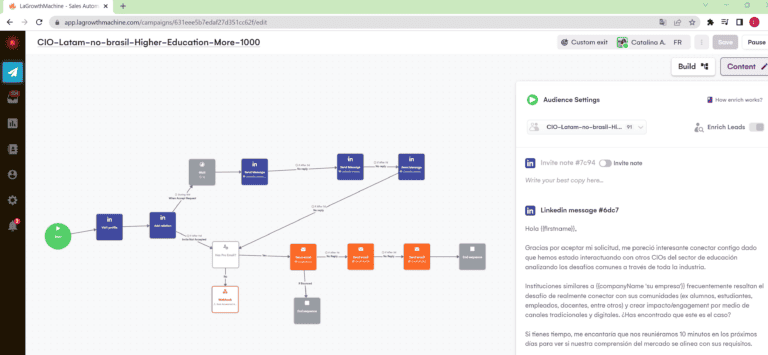
Once you’ve built up your prospecting files, you need to analyze them. For your outbound campaign, a database is scored according to 2 criteria: the number of acquisition channels and the amount of information to personalize the approach.
We’ve taken LinkedIn Sales Navigator as our source, so we have the LinkedIn URLs of our prospects that we can use in our automation tools. Then, if you want to use email, you need to enrich it (see article on emailing). If we were to sum up the development of an outbound strategy in broad terms, here’s what we’d do:
-
Setting up databases using double filtering
-
Enrich it : Professional email + telephone
-
Copywriting: LinkedIn, email and telephone prospecting scripts
-
Setting up automation tools on LinkedIn and email
-
Launch
Multi-channel is the key to a successful outbound approach. In other words, you’ll be prospecting on LinkedIn, by e-mail and by telephone. In Part 3, we’ll look at the various additional outbound channels you can implement and how to manage the influx of responses.
Would you like support with your outbound campaigns?
Other Outbound levers to boost growth
A good outbound strategy is always combined with good structuring and exemplary follow-up. You don’t want to send hundreds of messages a day and have your sales team unable to keep up. You therefore need to adapt the volume to the processing capacity of your teams.
For example, if one of your sales reps makes 10 appointments a week but doesn’t have the time to feed your CRM, it’s better to reduce prospecting quotas. It’s better to have 7 well-documented appointments per week in your CRM than 10 poorly documented ones, as this has a direct impact on your closing rate.
Let’s talk CRM!
Structure and optimize your prospecting with CRM
There are many CRMs on the market, and here are the ones I prefer, depending on the phase and type of business:
-
Pipedrive: one of the best-designed tools for sales reps, simple and effective, it can easily be integrated natively into your prospecting tools like La Growth Machine and your enrichment tools like Dropcontact. This is useful for a “traditional” B2B company that doesn’t necessarily need powerful marketing support. Pipedrive is well designed for salespeople, but struggles to bridge the gap and create complementarity between sales, marketing and production teams.
-
Hubspot: the most complete CRM on the market, but expensive. I’ll leave you to discover it, because there’s a lot to say about it, and that will be the subject of a future article.
-
Notion: you can create your own CRM, so it’s perfect for B2B companies with special processes.
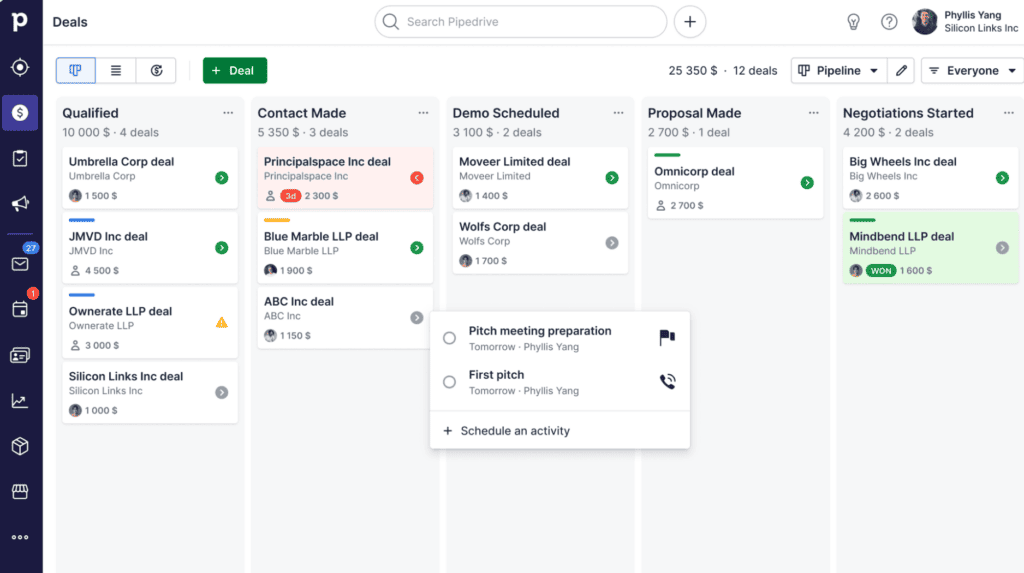
Be careful! Keep your CRM clean ! When you automate, the conversations generated need to be scored. In other words, your sales rep must first talk to the prospect before entering him or her into the CRM.
As a reminder CRM is the space for managing and tracking leads/customers. It’s not a tool for managing your leads, otherwise it would quickly become overloaded with lines.
Let’s do a quick calculation: 2000 people contacted per month on 1 LinkedIn profile with a response rate of 15% represents 300 people. A sales rep can’t keep up with 300 new people every month, so it’s necessary to clean up. Of these 300 people, 30 will actually go for a meeting and have the budget for your product or service.
To learn more about CRM management and how it can be synchronized with prospecting, read this article written by our N8N expert: “How to synchronize Piwaa and your CRM with N8N“.
Other B2B channels: SMS Marketing / Whatsapp / Postcards...
As part of a comprehensive outbound strategy, don’t hesitate to try out different acquisition channels. I was talking about the “note” of an Outbound database, but if you’re looking for telephone numbers or postal addresses, there are other techniques available to you 😉
When it comes to postal addresses, the French reference tool is Manuscry. It’s literally amazing. The prospect has no way of knowing that it wasn’t you who wrote the postcard in question with your finest pen. Having tested it, this channel works well in the context of offline levers, particularly trade shows, where you invite your audience to visit your stand and, on presentation of this card, a small gift awaits them.
We’ve tested and validated it with Hivebrite in particular. If your target is not very present on social networks and mailings, postcards are a good way to contact them. For example, with Qualiretraite, our targets are retired people. These people no longer have any reason to have a LinkedIn account, let alone a professional e-mail address, and canvassing by post is more popular than cold calling, where our customer would be competing with CPF companies…
It’s an expensive channel, and less trackable than other channels. So be careful before you use it, and make sure your acquisition funnel is running smoothly. For more details on the acquisition funnel and the AARRR method in general, read “Whatis a growth hacker job?“.
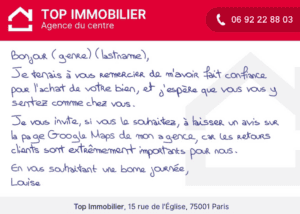
As far as telephone numbers are concerned, there are other things to do than cold calling, even if this lever is important (and should be part of every B2B business). It is not the only acquisition channel when we have this data. If your sales force doesn’t have the time or skills to manage this, SMS Marketing or Whatsapp are two good ways of generating qualified appointments. A few months ago, Whats’App opened up this feature to all businesses. To find out more, please contact me directly. This article is getting long and I’m afraid I’ve already lost readers, if you’re still here, well done!
Conclusion: Outbound Marketing, a spearhead for growth
In conclusion, there are 2 main strategies for stimulating business growth, and more specifically acquisition: inbound and outbound marketing. Outbound marketing is an area to focus on, because this is where the famous 30% growth is hidden.
To set this up, you need knowledge of databases and the various automation tools available on the market. Good prospecting boils down to two things: the quality of the database and the number of channels used to trigger an appointment. If a channel doesn’t work, it’s often not because the future consumer has no need for your service or product, but because the channel used wasn’t suitable.
In the acquisition funnel, an outbound lever that we haven’t covered in this article is the “Dedicated landing page”. This more marketing-oriented aspect is a good example of the interdependence and complementarity between sales people and marketers. It concentrates field feedback and sales databases in the skills of your marketing team to convert a prospect who wanders onto a landing page written just for him.
